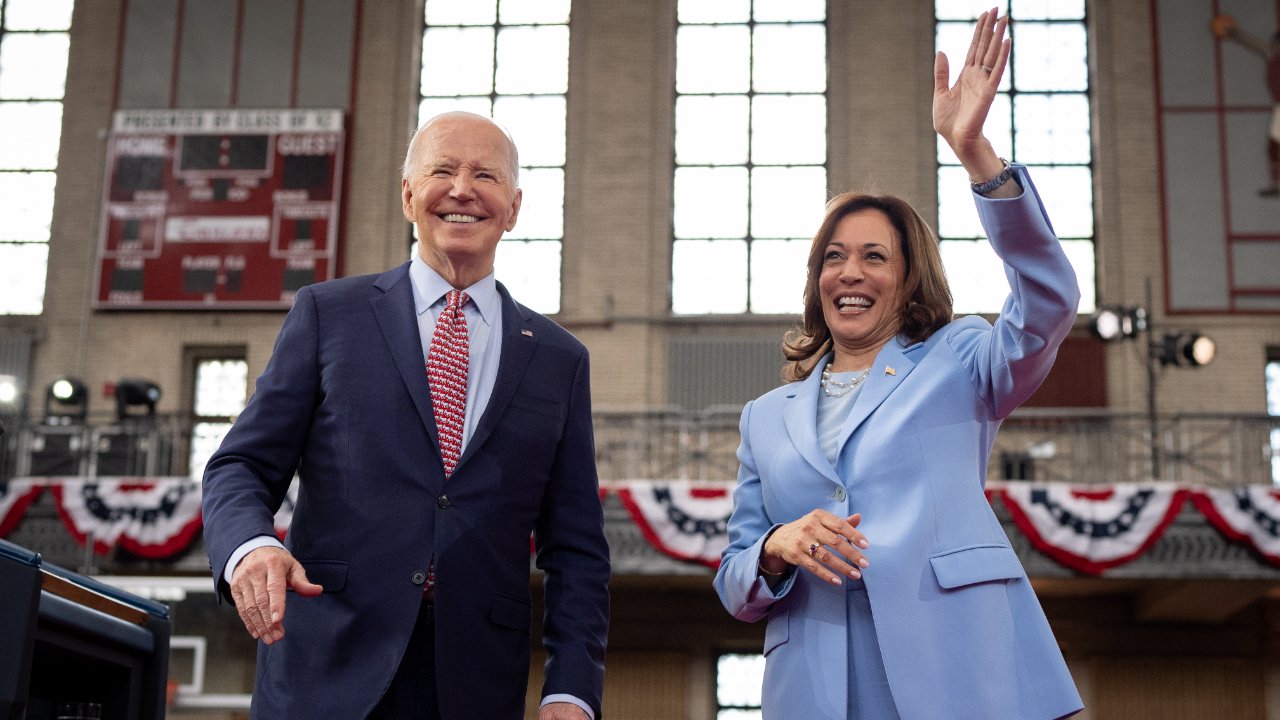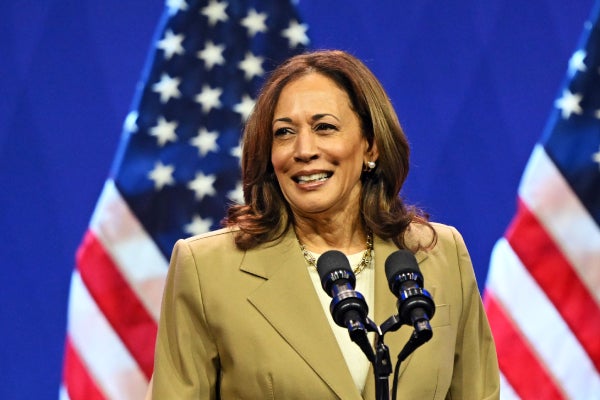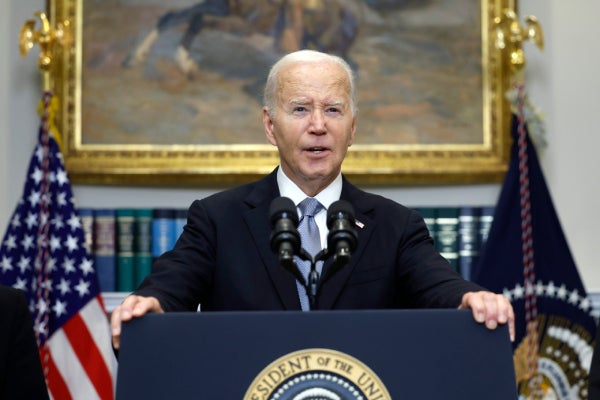How could a Harris presidency impact your finances? Her record offers some clues — and diverges some from Biden

Key takeaways
- Vice President Kamala Harris' economic platform would likely align with Biden’s, focusing on issues like prescription drug costs, student loan debt, housing affordability and the expiration of Trump’s Tax Cuts and Jobs Act.
- Harris' previous positions on college affordability, minimum wage, housing affordability, tax policy, health care and Social Security reflect a mix of both Biden-like stances and more progressive ideas.
- No matter the result of the election, keep steady with your retirement savings plan and make emergency savings a priority to establish a secure, lasting financial foundation.
Less than three hours after President Joe Biden canceled his bid for reelection, Vice President Kamala Harris declared her intentions to take his place. Her swiftness may be necessary for the occasion.
With Harris now the presumptive nominee, Americans will have about 100 days — the shortest presidential election campaign in modern U.S. history — to get to know the new face of the Democratic ticket, including how her stances on money-related issues differ from Biden’s.
This late in the game, Harris will likely hew closely to Biden’s platform, political strategists and policy analysts tell Bankate. That means focusing on lowering prescription drug costs, alleviating student loan debt and addressing housing affordability, among other priorities. Her economic stances offer voters a sharp contrast to former President Donald Trump, whose administration would be focused on tax cuts, deregulation and tariffs.
“You’ve got a limited amount of time to get a lot of information out about yourself as a candidate to the public,” says Paul Christopher, head of global market strategy at the Wells Fargo Investment Institute. “You have to consider whether the policies that have already been worked out in some detail would be a better way to approach the election.”
To help Americans learn more about all the ways the presumptive Democratic nominee could impact their personal finances, Bankrate delved into Harris’ previous proposals and remarks throughout her 20-plus years as a public official. Some of her previous positions, on issues such as college affordability and minimum wage, appear in line with Biden’s. Others, such as her past position on a single-payer health care system and tax credits for families, may be even more progressive.
College affordability

Supported free community college for all and free tuition at a public four-year university for middle-class students

Supported free community college for all and free tuition at a public four-year university for middle-class students
In her earlier years as a U.S. senator, Harris aligned her college views with Sen. Bernie Sanders, an Independent from Vermont, and Sen. Elizabeth Warren, a Democrat from Massachusetts.
She co-sponsored Sanders’ 2017 “College For All Act” that would’ve eliminated tuition and fees for all students at community colleges and middle-class students whose families earned $125,000 or less at four-year universities. A year later, she backed the even more expansive “Debt-Free College Act of 2018” from Sen. Brian Schatz, a Democrat from Hawaii, which proposed covering students’ “unmet financial needs,” or the cost of attendance minus financial and family aid.
“College has become a dream that is weighed down with a giant price tag that an individual could only imagine taking on,” Harris said at the time. “We must take action and address this crisis before it’s too late.”
On the 2020 campaign trail, Biden mirrored Harris’ position on college tuition, pledging to make four-year public colleges and universities free for families whose income was below $125,000. He also supported free community college, a position that he’d later revive in his $7.3 trillion budget for fiscal year 2025.
Nearly 1 in 5 adults (18 percent) say student loan debt will have a major influence over their vote in the upcoming 2024 presidential election
Source: Bankrate’s Student Loans and Presidential Elections Survey
Student loan debt

Initially supported a narrow forgiveness plan for Pell Grant recipients but later went on to sway Biden to institute mass student loan forgiveness, according to reports

Created a new income-driven repayment plan known as the Saving On A Valuable Education (SAVE) plan and canceled roughly 10% of all federal student debt
A defining part of Biden’s legacy, at least for young voters with student loan debt, will likely be the chief executive’s attempt to forgive up to $20,000 for eligible middle-class student loan borrowers earning less than $125,000 — even if it was ultimately blocked by the Supreme Court.
But behind closed doors, Biden allegedly remained skeptical about approving wide-sweeping forgiveness at first, according to a 2022 investigation from The New York Times. Harris, however, was one of its most prominent supporters, going as far as enlisting her staff members to draft a memo detailing talking points for the presidents’ concerns, The Times’ reporting found.
It represents an evolution from her earlier stances on the issue. On the campaign trail in 2020, Harris proposed forgiving student loan debt only for Pell Grant recipients who’ve had a small business in a “disadvantaged community” for at least three years, a narrower measure than the Biden administration’s wide-sweeping forgiveness proposal.
Altogether, the Biden-Harris administration has gone on to forgive more student loan debt than any other in U.S. history: over $168 billion, or about 10 percent of all student loan debt. Most of that relief has gone toward Americans who’ve made eligible payments on an income-driven repayment plan, including his new Saving On A Valuable Education (SAVE) plan, as well as Americans on Public Service Loan Forgiveness (PSLF) programs and those with debt from for-profit colleges.
Wages

Supported a $15 federal minimum wage and equal pay initiatives for women

Raised minimum wage for federal workers and federal contractors to $15
By the time Harris hit the 2020 presidential campaign trail, she’d already been a co-sponsor of Sanders’ “Raise the Wage Act.” The legislation would have amended the Fair Labor Standards Act of 1938 to increase the federal minimum wage to $15 from $7.25 in phases over a seven-year period for regular, tipped and newly hired employees. Then, future increases would’ve been indexed to median wage gains annually.
“As president, she will make the fight to raise the federal minimum wage to $15 a top priority,” Harris’ campaign declared during her 2020 presidential run.
Biden similarly supported a $15 minimum wage on the campaign trail and included the across-the-board increase in his massive $1.9 trillion American Rescue Plan COVID-relief package. The plan, however, was blocked in the Senate. The president eventually ended up signing an executive order in 2021 that granted a $15 minimum wage for all federal workers and contractors.
The Biden-Harris administration also finalized a rule that would make lower-income salaried workers eligible for more overtime, mirroring similar legislation from the Obama administration that got rolled back when Trump was in office.
Another key platform for Harris involved closing the gender pay gap. While running for president in 2019, she proposed requiring that companies employing more than 100 people receive an Equal Pay Certification through the Equal Employment and Opportunity Commission (EEOC) or else face fines on their profits. She also wanted to mandate that companies report statistics on the percentage of women in leadership positions.
Housing affordability

Backed a tax credit for renters who pay more than 30% of their gross income on housing and utilities

Proposed a first-time homebuyer tax credit worth $10,000 and a 5% rent increase cap for corporate landlords
In an era of high inflation, expensive interest rates and limited inventory, housing affordability issues are a top concern for many Americans. More than 3 in 4 (78 percent) consider owning a home to be a part of the American Dream, but affordability remained a top obstacle, according to Bankrate’s 2024 Home Affordability Report.
One of Harris’ most sweeping proposals as a senator was the “Rent Relief Act,” which aimed to create a new, refundable tax credit for renters spending more than 30 percent of their gross income on rent and utilities. Depending on the renters’ income, the size of the credit would’ve ranged from 25 percent to 100 percent of the excess rent, a summary of the bill states. Almost a year after Harris’ legislation, Biden supported a similar proposal during his own 2020 presidential run, though he didn’t extend eligibility to Americans living in government-subsidized housing.
The question now is whether Harris plans to reintroduce this credit. Harris has been heavily involved in the current administration’s affordability proposals, directly announcing recipients of an $85 million grant to build new housing under the new Pathways to Removing Obstacles to Housing (PRO Housing) initiative through the U.S. Department of Housing and Urban Development (HUD).
At Biden’s 2024 State of the Union address, the chief executive unveiled new details on the Biden-Harris Housing Plan, which proposed a $10,000 tax credit for first-time homebuyers and eligible sellers and detailed plans to build 2 million homes. In July, Biden announced additional housing affordability proposals: a 5 percent annual rent increase cap on corporate landlords.
Casting support for the initiative, Harris released a statement on X later that day.
“Every American deserves affordable housing — yet the cost is too high in communities across our nation,” Harris posted July 16 on X.
Tax policy

Proposed the Livable Incomes for Families Today (LIFT) the Middle Class Act, which would provide middle-class Americans with a tax credit of up to $6,000 per year ($500 monthly)

Supported raising the top-line marginal tax rate but pledged not to raise taxes on those earning under $400,000. Proposed boosting capital gains taxes and corporate tax rate to 28%
The next president will likely have a big decision to make for American taxpayers. Come 2025, some parts of the 2017 tax cuts from the Trump administration are set to expire, including provisions that lowered tax rates for filers at almost every income spectrum. If Congress does nothing, tax rates will creep back up across the board.
Biden and Harris have generally backed the same tax policy principles (walking back some of the Trump-era tax reforms while also raising corporate tax rates) but have diverged over how to implement them.
Biden, on the one hand, opposed raising taxes for earners who make less than $400,000 a year, a clear stance Harris has yet to take. While running for president in 2020, Biden campaigned on restoring the top-line marginal tax rate of 37 percent to 39.6 percent.
Meanwhile, Harris backed increasing the corporate tax rate of 21 percent — one of the permanent features of the Trump-era tax reform — to 35 percent, higher than Biden’s preferred 28 percent.
Harris also said in 2019 that she would “repeal the Trump tax cuts” to pay for one of her biggest proposals during her election bid: the Livable Incomes for Families Today (LIFT) the Middle Class Act. Floated originally as a senator, the proposal outlined providing up to $3,000 a year ($250 monthly) for single adults and up to $6,000 per year (or $500 monthly) for married couples to help close the wealth gap.
On the campaign trail, Harris also supported taxing Wall Street trades to pay for her “Medicare for All” plan and boosting estate taxes to give the average teacher in the U.S. a $13,500 pay increase.
One clear overlap between Biden and Harris: Both have rallied behind expanding the child tax credit (CTC) again. After Trump’s tax code changes first bumped up the credit from $1,000 to $2,000, the Biden-Harris administration later temporarily lifted the amount to $3,600 for children under age 6 and $3,000 for other children under age 18 in its 2021 American Rescue Plan.
The House in February passed a bill that would expand the program again, likely making it a bigger priority for the party — and Harris, as her campaign heats up again.
“Whereas the last administration gave tax cuts to billionaires, we gave tax cuts to families through the child tax credit, which cut child poverty in America by half,” Harris said at an event in North Carolina before Biden dropped out of the presidential race.
Health care

Proposed a “Medicare for All” program that would still allow for private insurance

Preferred a government-run insurance option similar to the Affordable Care Act
Harris and Biden’s most notable divisions on the run up to the 2020 presidential elections were about health care.
Harris floated her own version of “Medicare for All” that gave Americans the option to enroll in a single-payer health care system — or remain with private insurance if they preferred — over a 10-year transition period. Biden, on the other hand, preferred maintaining the current system while adding a government-run insurance option similar to the Affordable Care Act.
Neither fully panned out, though Biden and Harris did oversee sweeping changes to the health care system while in office. The Democrats’ 2022 Inflation Reduction Act granted Medicare the authority to renegotiate prescription drug prices and limit hikes, capping things like insulin copays at $35 and out-of-pocket maximums for seniors at $2,000. The administration hoped to expand some of those cost-saving initiatives to the broader commercial market, according to a fact sheet on the president’s 2025 fiscal year budget.
Social security

Co-sponsored the “Social Security Expansion Act” to increase benefits while raising taxes to cover a funding shortfall

Supported increasing benefits and Social Security payroll taxes for higher-income Americans to help address funding shortfalls
The next president will also likely be under pressure to find a way to preserve Social Security, with the latest estimates from the Social Security Board of Trustees estimating it could reach insolvency by 2035.
Both Biden and Harris have differed in their approaches to protect the key retirement safety net.
Harris previously co-sponsored the “Social Security Expansion Act,” now spearheaded by Sanders. The proposal would’ve increased benefits across the board while also expanding the 12.4 percent payroll taxes on wages, salaries and self-employment earnings for earners making more than $250,000 — aptly described as a “donut hole” policy. Currently, the maximum earnings subjected to Social Security taxes is $168,600, according to the Social Security Administration.
Biden, meanwhile, wanted to exclude more workers from higher payroll taxes, implementing the tax only on those who earn $400,000 or more.
When it comes to monthly benefits, Biden wanted to set payments at 125 percent of the federal poverty level and expand Social Security for the country’s oldest Americans who’ve been on the program for at least 20 years.
Will Harris’ platform mirror her 2020 presidential election bid?
As Harris appears to clinch the number of delegates she needs for the nomination, the Democratic party’s new challenger is traversing a familiar road in a dramatically different territory.
For starters, the nation is facing its worst inflation crisis in 40 years. Total debt held by the public also now makes up over 122 percent of the U.S. economy’s total output, among the highest levels ever recorded, according to data from the St. Louis Fed. And with interest rates now the highest in over 20 years, the government’s cost of financing its debt has also become a bigger burden.
“The 2020 presidential election was a vastly different time from an economic standpoint and a global standpoint,” says Gabe Horwitz, who directs the modern center-left Washington-based think tank Third Way’s economics program. “Anybody’s policies, anybody’s agenda, are going to have to be evaluated in this new economy and new global situation.”
It’s not yet clear what platforms Harris will champion. She could dust off her previous election playbook, promote the Biden-Harris administration’s policies or find some middle ground. Yet, experts don’t expect her to campaign on a materially different platform than Biden.
“Over the last three and a half years, the Biden-Harris administration has had a mainstream moderate agenda,” Horwitz added. “My assumption is that the vice president continues that going forward.”
Proposals floated on the campaign trail are also far from a reality, ultimately depending on the makeup of Congress. Before Biden dropped out of the race, projections from Moody’s Analytics predicted that a divided government would be the most likely scenario. The Democrats’ slim 51-49 majority in the Senate is threatened by four open seats that currently look like a toss up, according to the Cook Political Report. A divided government would likely keep many of Harris’ proposals from seeing the light of day.
Regardless of the election outcome, Americans should keep a long-term perspective. Continue staying the course with your retirement savings and prioritize saving for emergencies to put yourself on solid, long-term financial footing.
“Our investing time horizon could be 50, 60, or 70 years. We could have 10 presidents during that time,” says Greg McBride, CFA, Bankrate chief financial analyst. “If you overhaul your portfolio every time there is an election, you’ll do more spinning your wheels than anything.”
You may also like

How a speeding ticket impacts your insurance in Illinois





